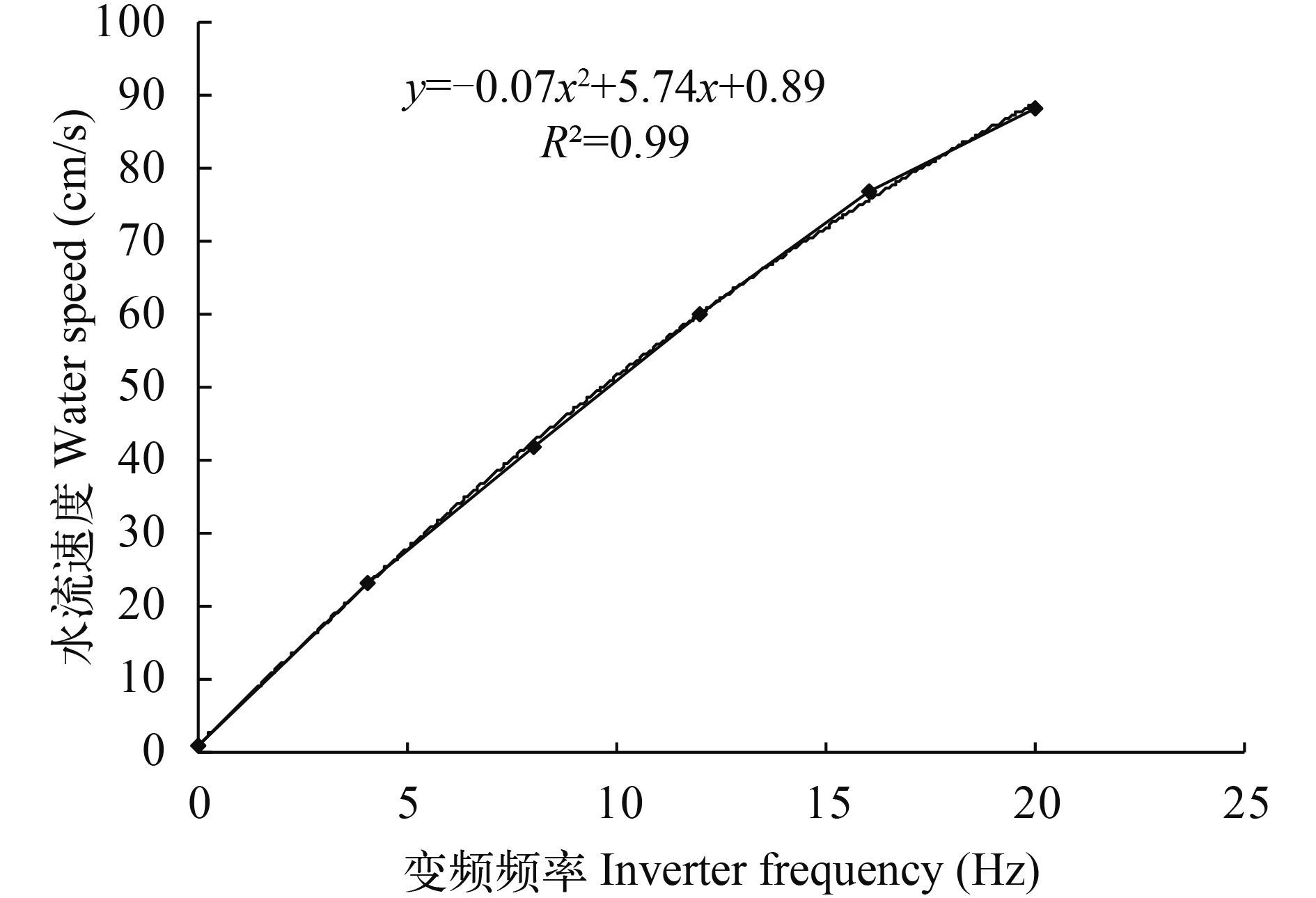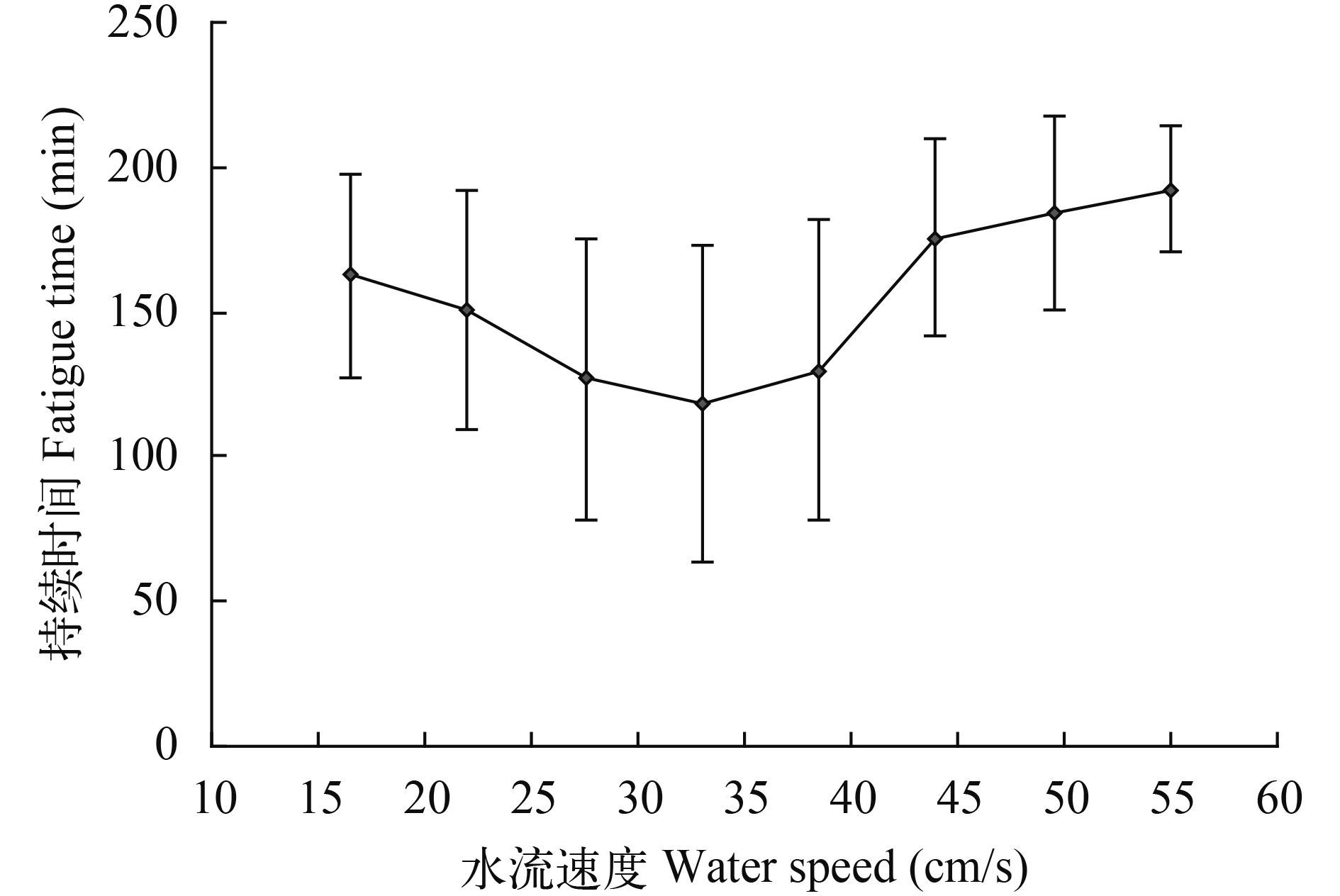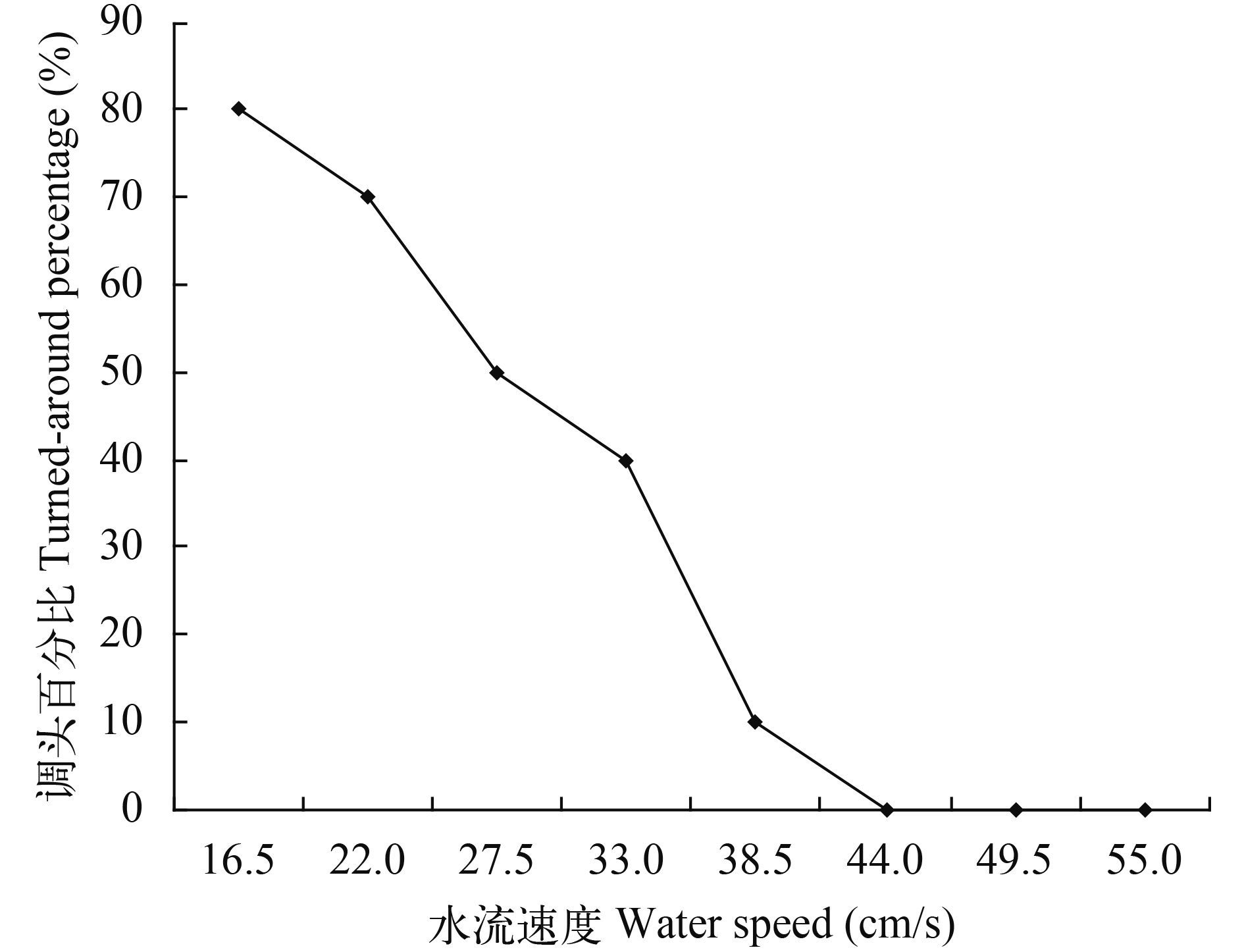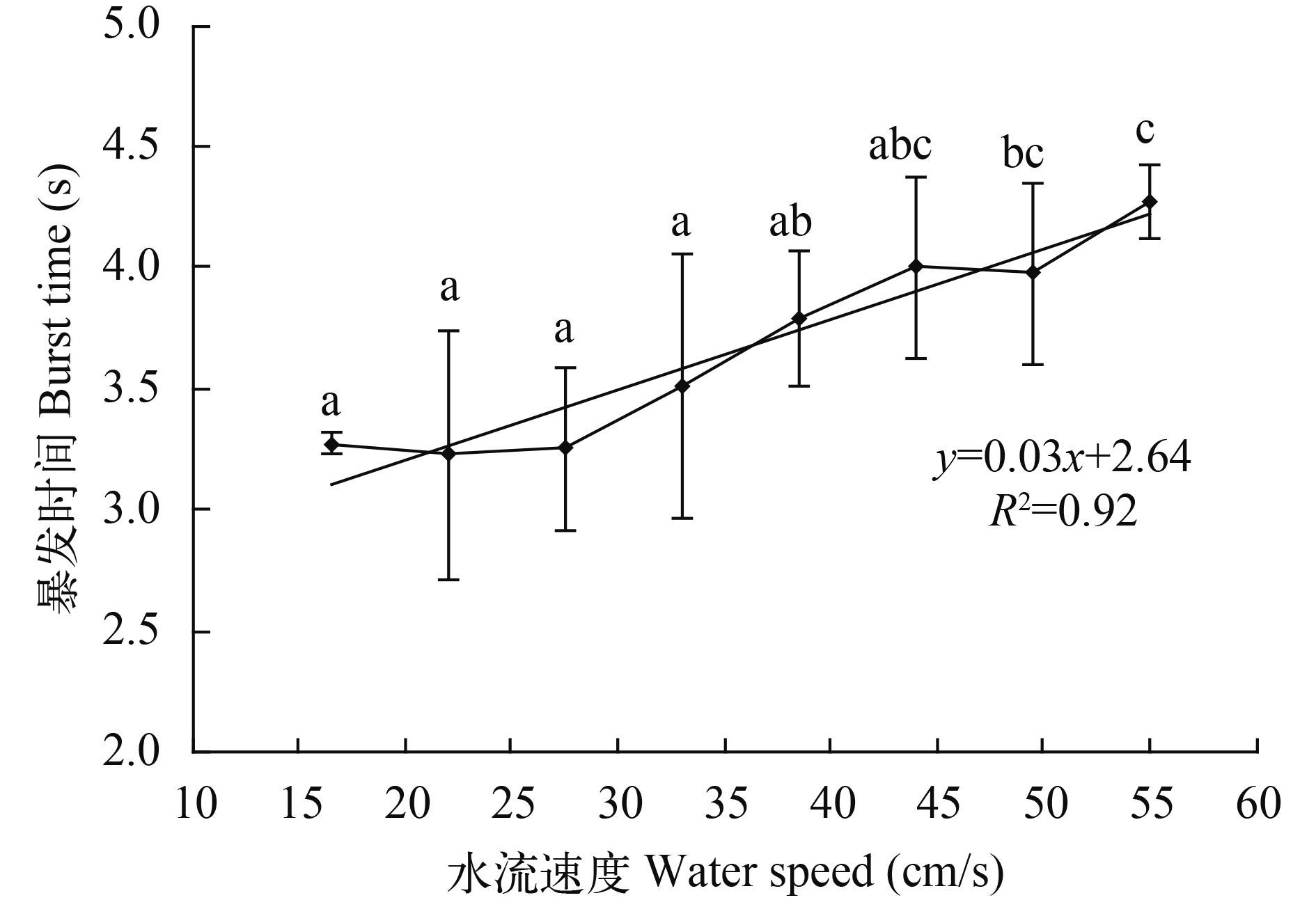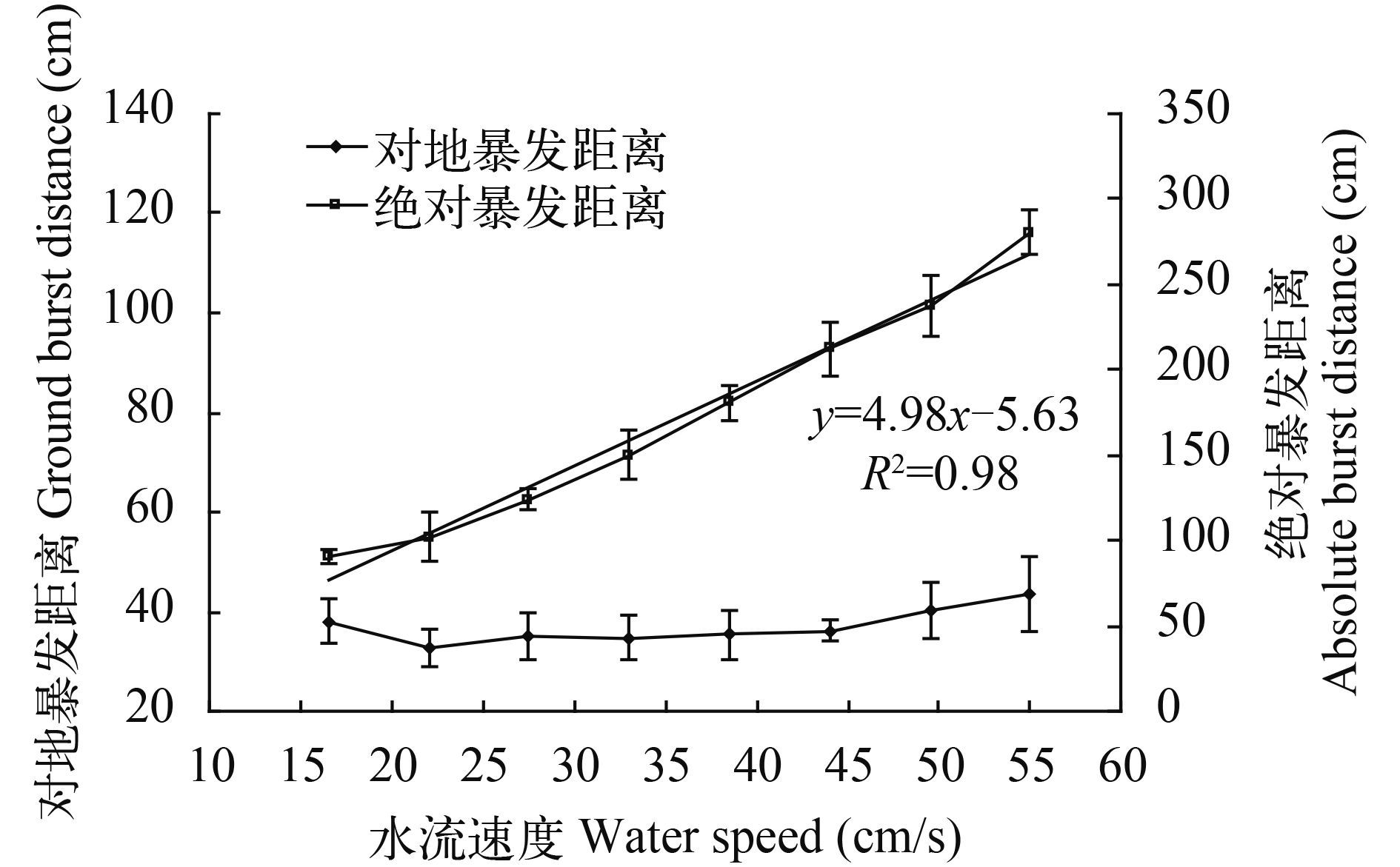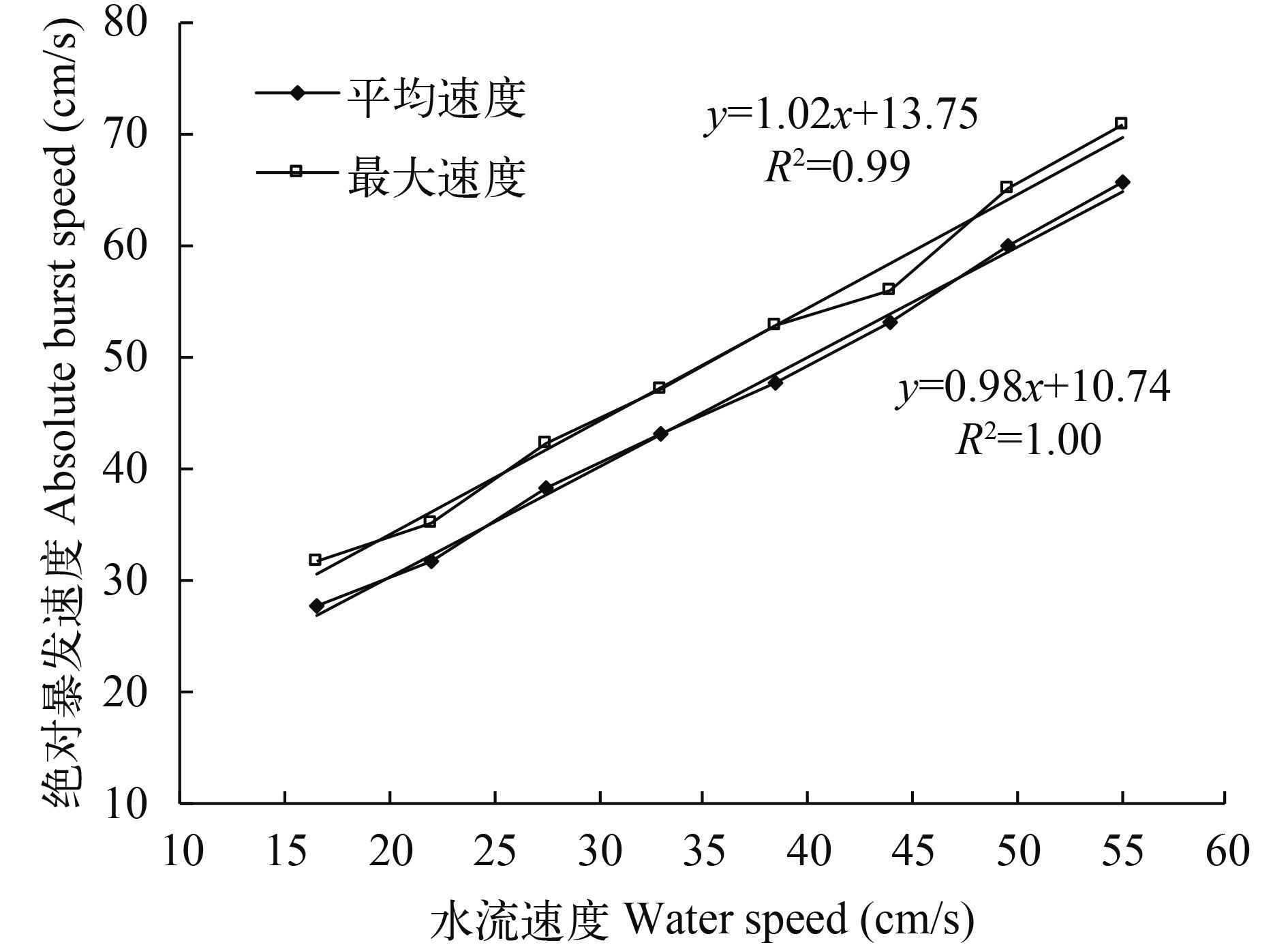STRATEGIES OF BURST-COAST SWIMMING BEHAVIOR OF JUVENILE SILVER CARP AT DIFFERENT FLOW VELOCITIES
-
摘要: 在水温(18±1)℃的条件下,以全长(11.70±0.57)cm的鲢(Hypophthalmichthys molitrix)幼鱼为研究对象,测定其不同流速(16.5、22.0、27.5、33.0、38.5、44.0、49.5和55.0 cm/s)下的持续游泳时间、调头百分比和暴发-滑行运动数据。结果表明,鲢的平均持续游泳时间先随流速的增加而减小,后随流速的增加而增加。当流速33.0 cm/s时,平均持续时间最短为118.6min,其中各组试验鱼的最大可持续游泳时间均可达到200min。调头百分比随流速的增加迅速减小,当流速≥44.0 cm/s时,不再出现调头行为。暴发-滑行游泳的平均暴发时间随流速的增加呈上升趋势(y=0.03x+2.64,R2=0.92,P<0.05)。平均对地暴发距离均在30-45 cm,没有显著性差异(P>0.05),平均绝对暴发距离存在极显著性差异,且随流速的增加而增加(y=4.98x-5.63,R2=0.98,P<0.001)。平均对地暴发速度没有显著性差异(平均对地平均速度和最大速度分别在9-12 cm/s、12-16 cm/s,P>0.05)。平均绝对暴发速度与水流速度之间存在线性正相关关系(平均绝对平均暴发速度:y=0.98x+10.74,R2=1.00,P<0.001;平均绝对最大暴发速度:y=1.02x+13.75,R2=0.99,P<0.001)。研究表明鲢在不同的流速下采取的暴发-滑行行为策略不同。Abstract: At the water temperature of (18±1)℃, the current study investigated the strategies of burst-coast swimming behavior of juvenile Silver carps Hypophthalmichthys molitrix (at full length of 11.70±0.57 cm) such as swimming duration, percentage of turned-around, burst time, distance and speed in the burst-coast performance at different flow velocities (16.5, 22.0, 27.5, 33.0, 38.5, 44.0, 49.5 and 55.0 cm/s). Results showed that the average swimming duration of silver carps first decreased and then increased with the increasing flow velocity. The shortest duration time is 118.6min when fish swim at 33.0 cm/s. The maximum duration of swimming in each group was more than 200min. The percentage of turned-around quickly decreased with the increasing flow velocity, while no turned-around behavior occurred at the flow velocity ≥44.0 cm/s. The average burst time of burst-coast swimming of silver carp were positively associated with flow velocity (y=0.03x+2.64, R2=0.92, P<0.05). Average burst distances relative to the ground for each group were at the range of 30-45 cm without significant difference (P>0.05). However, the average absolute burst distances increased significantly with the increase of flow velocity (y=4.98x-5.63, R2=0.98, P<0.001). The average mean burst velocities relative to the ground and average maximum burst velocities relative to the ground had no significant difference (P>0.05), which were at the range of 9-12 cm/s and 12-16 cm/s, respectively. There was a positive linear relationship between average absolute burst velocity and flow velocity (absolute average mean burst speed:y=0.98x+10.74, R2=1.00, P<0.001. The absolute average maximum burst speed formulated by y=1.02x+13.75, R2=0.99, P<0.001). These data proved that silver carp took different burst-coast behavior strategies at different flow velocities.
-
Keywords:
- Silver carp /
- Velocity barrier /
- Swimming duration /
- Behavior strategy /
- Burst-coast
-
-
图 5 不同流速下鲢暴发时间的变化
线上不同字母表示差异显著性,相同字母表示差异不显著性,差异显著P<0.05,差异不显著P>0.05
Figure 5. Burst time of silver carp at different water speeds
Letters in each line indicate the extent of significant difference. The same letter indicates the difference is not significant. Significant difference P<0.05, and insignificant difference P>0.05
-
[1] Kemp P S, Williams J G. Illumination influences the ability of migrating juvenile salmonids to pass a submerged experimental weir[J]. Ecology of Freshwater Fish, 2009, 18(2):297-304 doi: 10.1111/eff.2009.18.issue-2
[2] 韩京成, 曹婷婷, 黄应平, 等. 温度和流速对齐口裂腹鱼幼鱼呼吸代谢的影响. 武汉大学学报(理学版), 2010, 56(1):81-86 http://www.cnki.com.cn/Article/CJFDTOTAL-WHDY201001020.htm Han J C, Cao T T, Huang Y P, et al. Effects of temperature and flow velocity on the respiratory metabolism of Schizothorax prenanti juveniles[J]. Journal of Wuhan University (Natural Science Edition), 2010, 56(1):81-86
韩京成, 曹婷婷, 黄应平, 等. 温度和流速对齐口裂腹鱼幼鱼呼吸代谢的影响. 武汉大学学报(理学版), 2010, 56(1):81-86 http://www.cnki.com.cn/Article/CJFDTOTAL-WHDY201001020.htm[3] Kemp P S, Russon I J, Vowle A S, et al. The influence of discharge and temperature on the ability of upstream migrant adult river lamprey (Lampetra fluviatilis) to pass experimental overshot and undershot weirs[J]. River Research and Application, 2011, 27(4):488-498 doi: 10.1002/rra.1364
[4] Silva A T, Santos J M, Ferreira M T, et al. Effect of water velocity and turbulence on the behaviour of Iberian barbel (Luciobarbus bocagei, Steindachner 1864) in an experimental pool-type fishway[J]. River Research and Application, 2011, 27(3):360-373 doi: 10.1002/rra.v27.3
[5] Theodore C S. Optimal swim speeds for traversing velocity barriers:an analysis of volitional high-speed swimming behavior of migratory fishes[J]. Journal of Experimental Biology, 2005, 208(3):421-432 doi: 10.1242/jeb.01380
[6] Webb P W. Hydrodynamics and energetics of fish propulsion[J]. Bulletin of the Fisheries Research Board of Canada, 1975, 190:1-159 http://cn.bing.com/academic/profile?id=1549935978&encoded=0&v=paper_preview&mkt=zh-cn
[7] 石小涛, 陈求稳, 黄应平, 等. 鱼类通过鱼道内水流速度障碍能力的评估方法. 生态学报, 2011, 31(22):6967-6972 http://www.cnki.com.cn/Article/CJFDTOTAL-STXB201122032.htm Shi X T, Chen Q W, Huang Y P, et al. Review on the methods to quantify fish's ability to cross velocity barriers in fish passage[J]. Acta Ecologica Sinica, 2011, 31(22):6967-6972
石小涛, 陈求稳, 黄应平, 等. 鱼类通过鱼道内水流速度障碍能力的评估方法. 生态学报, 2011, 31(22):6967-6972 http://www.cnki.com.cn/Article/CJFDTOTAL-STXB201122032.htm[8] Kieffer J D. Perspective-Exercise in fish:50+ years and going strong[J]. Comparative Biochemistry and Physiology, 2010, 156(2):163-168 doi: 10.1016/j.cbpa.2010.02.009
[9] Plaut I. Critical swimming speed:its ecological relevance[J]. Comparative Biochemistry and Physiology, 2001, 131(1):41-50 doi: 10.1016/S1095-6433(01)00462-7
[10] Webb P W. Body form, locomotion and foraging in aquatic vertebrates[J]. American Zoologist, 1984, 17:107-120 http://cn.bing.com/academic/profile?id=1984834887&encoded=0&v=paper_preview&mkt=zh-cn
[11] Tudorache C, Viaenen P, Blust R, et al. Longer flumes increase critical swimming speeds by increasing burst-glide swimming duration in carp Cyprinus carpio L.[J]. Journal of Fish Biology, 2007, 71(6):1630-1638 doi: 10.1111/j.1095-8649.2007.01620.x
[12] Videler J J, Weihs D. Energetic advantages of burst-and-coast swimming of fish at high speeds[J]. Journal of Experimental Biology, 1982, 97:169-178 http://cn.bing.com/academic/profile?id=2106077046&encoded=0&v=paper_preview&mkt=zh-cn
[13] Kieffer J D, Arsenault L M, Litvak M K. Behaviour and performance of juvenile shortnose sturgeon Acipenser brevirostrum at different water velocities[J]. Journal of Fish Biology, 2009, 74(3):674-682 doi: 10.1111/jfb.2009.74.issue-3
[14] Yang Y, Wu G H, Yu Y L, et al. A study on flow physics of burst-and-coast swimming of koi carp (Cyprinus carpio koi) based on measurements and numerical simulations[J]. Journal of Aero Aqua Bio-Mechanisms, 2010, 1(1):30-38 doi: 10.5226/jabmech.1.30
[15] Videler J J. Swimming movements, body structure and propulsion in Cod (Gadus morhua)[J]. Symposium of the Zoological Society of London, 1981, 48:1-27 http://cn.bing.com/academic/profile?id=88474599&encoded=0&v=paper_preview&mkt=zh-cn
[16] 万宏, 王兴松. 单驱动仿生机器鱼加速-滑行动态特性的数值研究. 机器人, 2012, 34(4):411-417 http://www.cnki.com.cn/Article/CJFDTOTAL-JQRR201204007.htm Wan H, Wang X S. A numerical study on the dynamics responses of a single actuated bio-mimetic robotic fish during burst-and-coast swimming[J]. Robot, 2012, 34(4):411-417
万宏, 王兴松. 单驱动仿生机器鱼加速-滑行动态特性的数值研究. 机器人, 2012, 34(4):411-417 http://www.cnki.com.cn/Article/CJFDTOTAL-JQRR201204007.htm[17] Wu G H, Yang Y, Zeng L J. Kinematics, hydrodynamics and energetic advantages of burst-and-coast swimming of koi carps (Cyprinus carpio koi)[J]. Journal of Experimental Biology, 2007, 210:2181-2191 doi: 10.1242/jeb.001842
[18] Frank E F, Jennifer F F, Cindy J X. Burst-and-coast swimming in schooling fish (Notemigonus crysoleucas) with implications for energy economy[J]. Comparative Biochemistry and Physiology, 1991, 100(3):633-637 doi: 10.1016/0300-9629(91)90382-M
[19] Blake R W. Functional design and burst-and-coast swimming in fishes[J]. Canadian Journal of Zoology, 1983, 61(11):2491-2494 doi: 10.1139/z83-330
[20] Chung M H. On burst-and-coast swimming performance in fish-like locomotion[J]. Bioinspiration and Biomimetics, 2009, 4(3):1-12 http://cn.bing.com/academic/profile?id=2039103601&encoded=0&v=paper_preview&mkt=zh-cn
[21] Dutil J D, Sylvestre E L, Gamache L, et al. Burst and coast use, swimming performance and metabolism of Atlantic cod Gadus morhua in sub-lethal hypoxic conditions[J]. Journal of Fish Biology, 2007, 71(2):363-375 doi: 10.1111/jfb.2007.71.issue-2
[22] Stocker S, Weihs D. Optimization of energetic advantages of burst swimming of fish[J]. Mathematical Methods in the Applied Sciences, 2001, 24(17-18):1387-1400 doi: 10.1002/mma.v24:17/18
[23] 石小涛, 陈求稳, 刘德富, 等. 胭脂鱼幼鱼的临界游泳速度. 水生生物学报, 2012, 36(1):133-136 http://ssswxb.ihb.ac.cn/CN/article/downloadArticleFile.do?attachType=PDF&id=2058 Shi X T, Chen Q W, Liu D F, et al. Critical swimming speed of young Chinese sucker (Myxocryprinus asiaticus)[J]. Acta Hydrobiologica Sinica, 2012, 36(1):133-136
石小涛, 陈求稳, 刘德富, 等. 胭脂鱼幼鱼的临界游泳速度. 水生生物学报, 2012, 36(1):133-136 http://ssswxb.ihb.ac.cn/CN/article/downloadArticleFile.do?attachType=PDF&id=2058[24] 路波, 刘伟, 梁园园, 等. 草鱼快速启动过程的加速-滑行游泳行为. 水产学报, 2014, 38(6):69-74 http://www.cnki.com.cn/Article/CJFDTOTAL-SCKX201406008.htm Lu B, Liu W, Liang Y Y, et al. The burst-coast swimming behavior of grass carp (Ctenopharyngodon idellus) during fast-start[J]. Journal of Fisheries of China, 2014, 38(6):69-74
路波, 刘伟, 梁园园, 等. 草鱼快速启动过程的加速-滑行游泳行为. 水产学报, 2014, 38(6):69-74 http://www.cnki.com.cn/Article/CJFDTOTAL-SCKX201406008.htm[25] 李想, 林小涛, 宋波澜, 等. 流速对红鳍银鲫幼鱼游泳状态的影响. 动物学杂志, 2010, 45(2):126-133 http://www.cnki.com.cn/Article/CJFDTOTAL-BIRD201002019.htm Li X, Lin X T, Song B L, et al. Effects of water velocity on swimming performances of juvenile Tinfoil barb Barbodes schwanenfeldi[J]. Chinese Journal of Zoology, 2010, 45(2):126-133
李想, 林小涛, 宋波澜, 等. 流速对红鳍银鲫幼鱼游泳状态的影响. 动物学杂志, 2010, 45(2):126-133 http://www.cnki.com.cn/Article/CJFDTOTAL-BIRD201002019.htm[26] 宋波澜, 林小涛, 王伟军, 等. 不同流速下红鳍银鲫趋流行为与耗氧率的变化. 动物学报, 2008, 54(4):686-694 http://www.cnki.com.cn/Article/CJFDTOTAL-BEAR200804013.htm Song B L, Lin X T, Wang W J, et al. Effects of water velocities on rheotaxis behaviour and oxygen consumption rate of tinfoil barbs Barbodes schwanenfeldi[J]. Acta Zoologica Sinica, 2008, 54(4):686-694
宋波澜, 林小涛, 王伟军, 等. 不同流速下红鳍银鲫趋流行为与耗氧率的变化. 动物学报, 2008, 54(4):686-694 http://www.cnki.com.cn/Article/CJFDTOTAL-BEAR200804013.htm[27] Castro-Santos T. Modeling the effect of varying swim speeds on fish passage through velocity barriers[J]. Transactions of the American Fisheries Society, 2006, 135(5):1230-1237 doi: 10.1577/T05-262.1
[28] 何大仁. 鱼类行为学. 厦门:厦门大学出版社. 1998, 141 He D R. Fish Behavior[M]. Xiamen:Xiamen University Publisher. 1998, 141
何大仁. 鱼类行为学. 厦门:厦门大学出版社. 1998, 141[29] 郑金秀, 韩德举, 胡望斌, 等. 与鱼道设计相关的鱼类游泳行为研究. 水生态学杂志, 2010, 3(5):104-110 http://www.cnki.com.cn/Article/CJFDTOTAL-SCAN201005022.htm Zheng J X, Han D J, Hu W B, et al. Fish swimming performance related to fishway design[J]. Journal of Hydroecology, 2010, 3(5):104-110
郑金秀, 韩德举, 胡望斌, 等. 与鱼道设计相关的鱼类游泳行为研究. 水生态学杂志, 2010, 3(5):104-110 http://www.cnki.com.cn/Article/CJFDTOTAL-SCAN201005022.htm[30] Brett J R. The respiratory metabolism and swimming performance of young sockeye salmon[J]. Journal of the Fisheries Research Board of Canada, 1964, 21(5):1183-1226 doi: 10.1139/f64-103
[31] Calles O, Olsson I C, Comoglio C, et al. Size-dependent mortality of migratory silver eels at a hydropower plant, and implications for escapement to the sea[J]. Freshwater Biology, 2010, 55(10):2167-2180 doi: 10.1111/fwb.2010.55.issue-10
-
期刊类型引用(18)
1. 瞿飞虎,姜晓娜,葛彦龙,翟钰姗,张玲,王继瑶,寇寒,李池陶,胡雪松,石潇丹,贾智英. 黄河鲤对饲料蛋白质需求量研究. 南方水产科学. 2024(04): 124-132 .  百度学术
百度学术
2. 易婉婷,华雪铭,颜克涛,宓水潮,蓝汉冰,杭莹,丛湘明. 酵母水解物与小肽对大口黑鲈幼鱼生长性能、肝肠健康与抗感染能力的影响. 上海海洋大学学报. 2022(05): 1097-1107 .  百度学术
百度学术
3. 曾本和,刘海平,王建,王万良,周建设,王金林,朱成科,张忭忭. 饲料蛋白质水平对拉萨裸裂尻鱼幼鱼肌肉氨基酸及蛋白质代谢的影响. 中国水产科学. 2019(06): 1153-1163 .  百度学术
百度学术
4. 徐兆利,曾本和,杨瑞斌,牟振波,李宝海,王万良,张忭忭,刘海平. 饲料蛋白质水平对拉萨裸裂尻鱼幼鱼免疫和抗氧化能力的影响. 动物营养学报. 2019(12): 5645-5654 .  百度学术
百度学术
5. 赵书燕,林黑着,黄忠,周传朋,王珺,王芸,戚常乐. 不同蛋白水平对2种规格石斑鱼生长性能、血清生化及肌肉品质的影响. 南方水产科学. 2017(04): 87-96 .  百度学术
百度学术
6. 孙金辉,范泽,张美静,程镇燕,白东清,乔秀亭. 饲料蛋白水平对鲤幼鱼肝功能和抗氧化能力的影响. 南方水产科学. 2017(03): 113-119 .  百度学术
百度学术
7. 孔纯,华雪铭,杨璐,刘韬,杨景丰,王坛,王刚,吴钊,施永海,税春,苏美英. 暗纹东方鲀饲料中豆粕替代鱼粉的营养生理效应及其与大豆抗原蛋白的相关性. 水产学报. 2017(05): 734-745 .  百度学术
百度学术
8. 李宗升,吴立新,李思萌,彭博文,赵博文. 鸡肉粉替代鱼粉对大菱鲆生长和体组成的影响. 水产科学. 2016(05): 486-491 .  百度学术
百度学术
9. 王荻,刘红柏. 施氏鲟抗热应激中草药免疫制剂的筛选. 大连海洋大学学报. 2016(06): 635-639 .  百度学术
百度学术
10. 吴金平,刘伟,蒋明,文华,吴凡,田娟,杨长庚. 大规格吉富罗非鱼幼鱼对饲料中胆碱的需要量. 动物营养学报. 2016(01): 256-264 .  百度学术
百度学术
11. 王坛,华雪铭,朱伟星,吴钊,孔纯,何亚丁,苏美英. 饲料溶菌酶添加水平对氨氮应激下吉富罗非鱼血清生化指标、抗菌性能和肝脏抗氧化能力的影响. 水产学报. 2016(05): 740-750 .  百度学术
百度学术
12. 王荻,廉超,刘红柏. 中草药添加剂对施氏鲟生长及血液生化指标的影响. 水产学杂志. 2016(03): 16-20 .  百度学术
百度学术
13. 王震,徐玮,麦康森,路凯,刘迎隆,艾庆辉. 饲料缬氨酸水平对军曹鱼鱼体脂肪含量、血浆生化指标和肝脏脂肪代谢基因表达的影响. 水生生物学报. 2016(04): 744-751 .  本站查看
本站查看
14. 吴金平,文华,蒋明,刘伟,吴凡,田娟,黄凤,任春. 生物素对吉富罗非鱼幼鱼生长、体成分及血清生化指标的影响. 西北农林科技大学学报(自然科学版). 2016(02): 15-22 .  百度学术
百度学术
15. 胡田恩,王玲,张春晓,宋凯,李金宝. 饲料中添加胆汁酸对牛蛙生长性能、体组成和营养物质表观消化率的影响. 水生生物学报. 2015(04): 677-685 .  本站查看
本站查看
16. 张晓雁,杜浩,危起伟,张艳珍,王彦鹏,蔡经江,刘志刚,乔新美,熊伟. 养殖中华鲟的产后康复. 水生生物学报. 2015(04): 705-713 .  本站查看
本站查看
17. 李剑,刘淑兰,史庆超,翟少伟. 饲料中添加槲皮素对吉富罗非鱼幼鱼生长性能、血清生化指标和非特异性免疫指标的影响. 饲料工业. 2014(16): 21-25 .  百度学术
百度学术
18. 范兴,陆玉芹,陈名帅,颜明月,陈德慰. 三卡因甲磺酸盐麻醉对罗非鱼离水保活的影响. 食品科技. 2014(09): 174-179 .  百度学术
百度学术
其他类型引用(16)



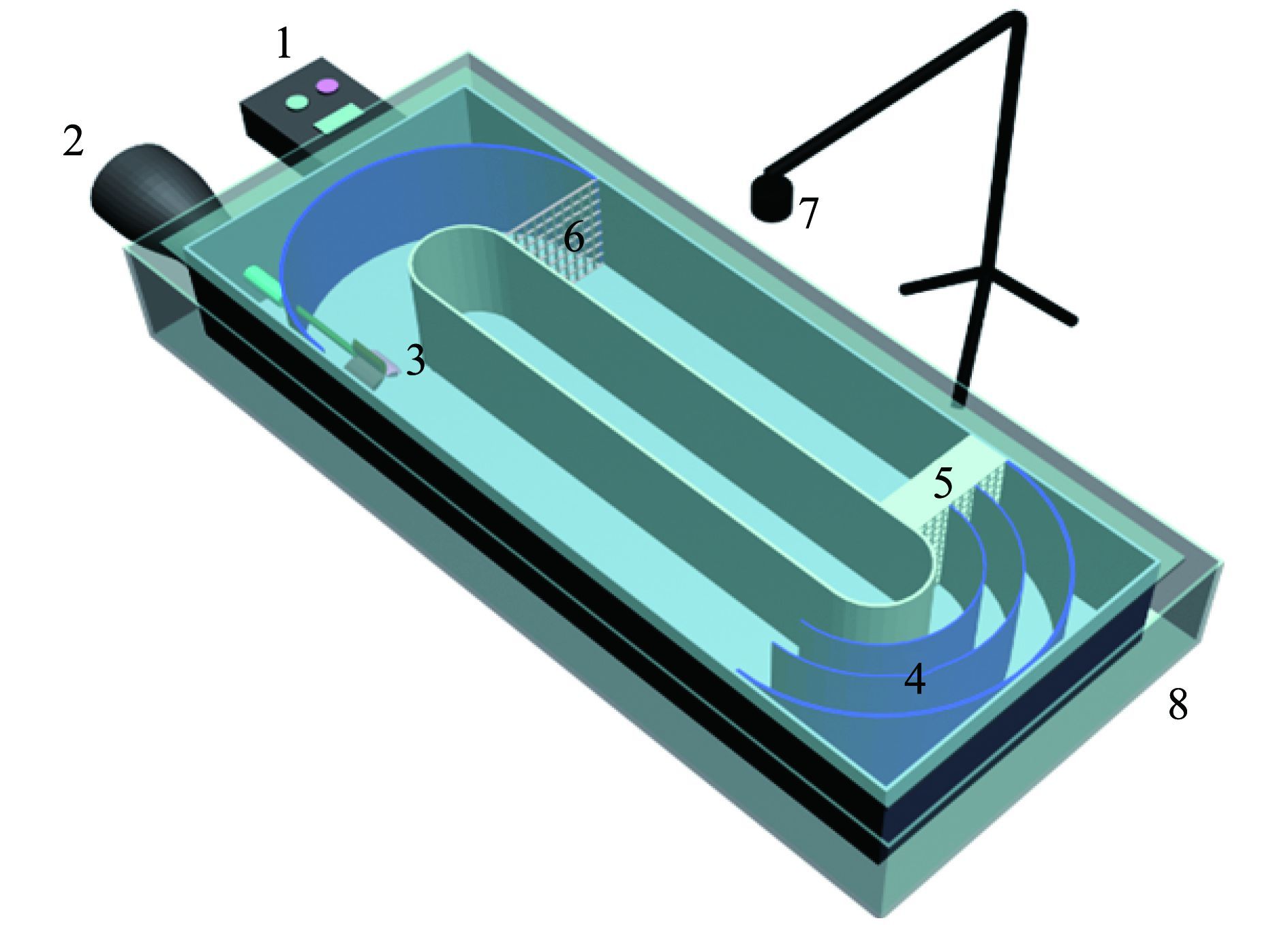
 下载:
下载:
